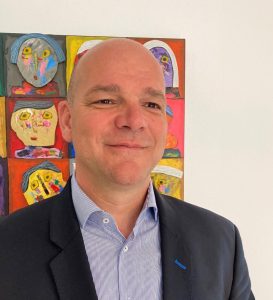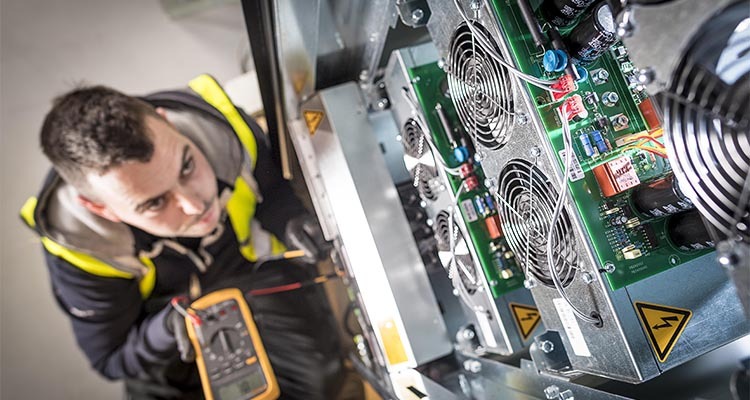Made in Britain: Legrand’s Green Growth in the UK
Legrand’s French roots date back as far as 1865, in Limoges, the place where it continues to operate today. The company was then established in the UK in 1971 and has grown considerably over time. Its growth has been fuelled by innovation and the steady stream of new, high value-added product launches, as well as acquisitions of companies that typically hold leading positions, and have specialised technological expertise in growing markets.
Today, the Legrand Group is a global specialist in electrical and digital building infrastructures, dedicated to supporting technological, societal, and environmental change around the globe. With nearly 38,000 employees around the world, the company strives to make the buildings of tomorrow more sustainable for everyone.
“We have been designing and manufacturing products in the UK since 1980,” begins Pascal Stutz, CEO – Legrand UK & Ireland, “and our six manufacturing sites in the UK create mechanical, electrical, electronic, and digital solutions that improve lives by transforming the spaces where people live, work and meet. Around 66 percent of our UK sales come from products designed and manufactured in the UK,” Pascal shares, adding that the business is proud to offer a variety of products, including metallic cable management, energy efficient lighting control systems, door entry systems, and assisted living and nurse call systems to name a few.
The last few years have been especially prosperous, with the company recently announcing a new brand vision. The aim is to align with its customers and be better placed to assist with solutions, as Pascal elaborates. “We wanted to simplify for our customers, be more solutions focused, and better structured to align with industry phases such as shell and core, and fit-out. We have multiple specialist brands, and we wanted to align those brands to work better together. We’d like the business to be powered by specialists but work more strongly together as a team to provide more complete solutions for our customers.”
Improving lives
Another exciting development saw the business obtain Platinum EcoVadis status for the third consecutive year. “We are incredibly proud to have achieved this for the third year in a row. It really is an important milestone on our ESG roadmap, and EcoVadis is being increasingly recognised throughout our industry. It’s our responsibility to provide concrete answers to the major societal challenges of our time, and this requires us to raise awareness not only in our own teams but also among our partners and customers. We need to bring them on board by our side as responsible players acting hand in hand with us. Our commitment to a low-carbon society is matched by our determination to guarantee a better future for our children and generations yet to come. This is why Legrand leverages the progress achieved in the framework of its previous ESG roadmaps and will continue to intensify actions in favour of an increasingly responsible development of its activities. This ambition is built around a simple and hopeful purpose: improving lives.”

Low carbon commitment
Keeping in tune with its ESG commitments, the business is making great strides across the organisation to improve its sustainability footprint. “Legrand transformers ensure efficient power distribution within data centres, optimising voltage levels and minimising energy losses during transmission. This improves overall energy efficiency and reduces wastage, leading to lower energy consumption and reduced utility bills,” he shares.
Furthermore, Legrand UPS solutions are designed with energy-saving features that include high-efficiency components and intelligent power management. This reduces energy consumption and leads to cost savings and environmental sustainability.
“Likewise, our containment and airflow racks for data centres are designed to create efficient airflow pathways, reducing hotspots and improving cooling effectiveness. This results in lower energy consumption by optimising the cooling system’s efficiency and reducing the workload on HVAC equipment.
“Innovative rear door cooling solutions use adaptive intelligence designed to control the whole room environment. The cooling management system continuously monitors temperature and controls cooling flow and fan speeds to maintain optimal temperature. This innovative technology is far more energy efficient, using less power to achieve the same level of cooling. Additionally, the design operates at higher supply water temperatures and can therefore utilise ambient free cooling.”
To keep up its high standards of efficiency, the business has made significant investments in its internal operations. “We already hold a market leading position in cable management, but we continue to invest. This year we are installing a new Industry 4.0 line for production of cable ladders that will increase our capacity and production speed, as well as bringing other benefits such as broadening our portfolio, reducing our environmental impact, and improving the production environment benefiting our factory operatives,” Pascal explains.
The business recently joined forces with Arcelor Mittal to purchase low-carbon steel. According to Pascal, this is progressing well. “Legrand has set itself the goal of reaching carbon neutrality throughout the group’s value chain. We’re heavily invested in both the development and installation of equipment and solutions that improve building energy efficiency and enable Legrand users to reduce their energy consumption; as well as reducing environmental impact via circular economy product development principles. This eco-design approach concerns all stages of the product life cycle, and Legrand is committed to lower carbon raw materials with higher recycled content.”
Sustainable solutions
Taking this one step further, he shares that this year the business will start to make its first products from Cold Rolled XCarb recycled and renewably produced steel. “XCarb steel is made via the Electric Arc Furnace route using high levels of scrap steel and 100 percent renewable energy. The result is a product with an extremely low CO2 footprint compared to steel produced via the traditional blast furnace route. We have set a target for 30 percent of the steel that we use to be low carbon from 2025.”
Superior standards
Looking to the future, Pascal notes that in 2024, he expects construction market segments will continue to be challenging. “We will continue to grow our position in data centres and in particular solutions for AI, but also smart buildings, infrastructure, and more energy efficiency solutions. We have a particularly strong NPI pipeline in 2024, to impact in all those sectors.
“Beyond this year, we want to answer more globally to our customers’ problems by providing more customised solutions. We have done this already with our assisted living and UPS offers where services now account for around 50 percent of our revenue in those segments. We will also continue to make our products greener, more connected, and in particular, we will strength our position even further in the data centre vertical where the AI trend will require greater power delivery and cooling capabilities.
“We are very proud to be designing and manufacturing most of our products here in the UK. We continue to invest in our UK operations, and we have recently joined the Made in Britain organisation, so our products can now proudly carry the official mark for British manufacturing.”
In bringing the conversation to a close, Pascal shares his gratitude and excitement for the work the team continues to do. “Designing, manufacturing, and testing our products in the UK places us in the best position to be able to deliver on the high standards that we set ourselves. Our UK operation and resources have us best placed to ensure we can adapt to industry changes such as The Building Safety Act, which came into force last year, and is undoubtedly one of the most fundamental reforms of regulation across the construction and residential property sectors in living memory; and will have an impact on the work of everyone in the construction sector, including manufacturers.
“Another example is that there is no fire rating requirement nor product standard to which manufacturers of cable management systems must adhere. Thanks to the knowledge of our engineering team, we have been able to look outside the typical standards and regulations to identify a test/standard method that would allow us to offer a declaration of performance for our systems that gives a defined length of time during which integrity is maintained in a fire event. We have also launched a series of educational white papers and CPD seminars on this subject to help our customers better understand how to specify systems to ensure fire safety to defined levels,” he concludes.
